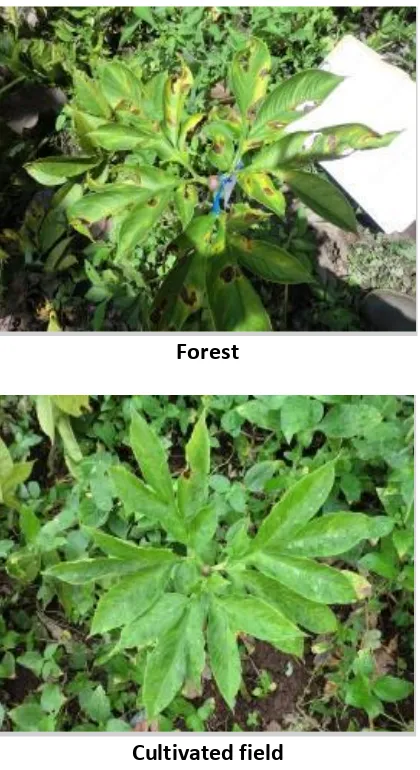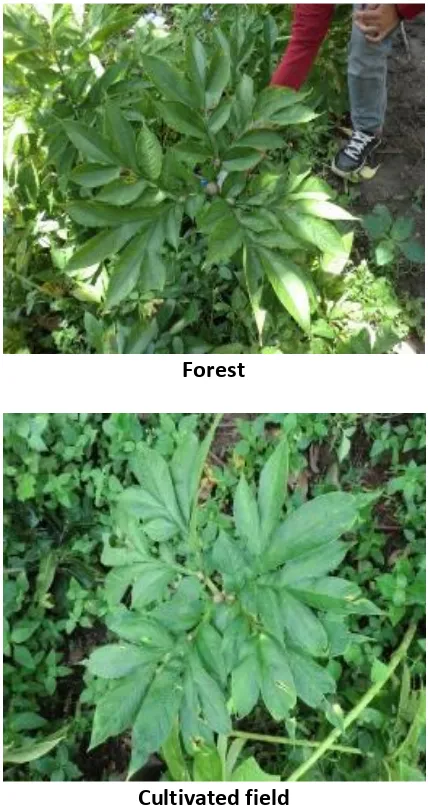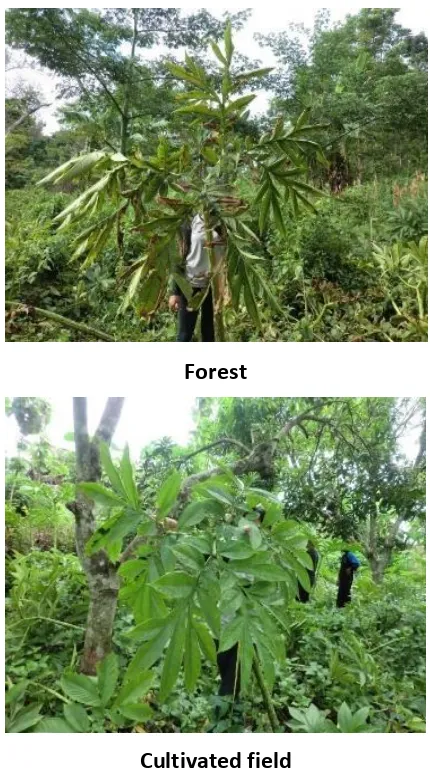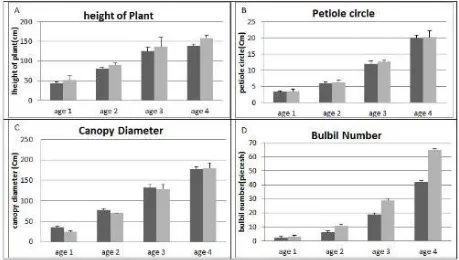Estimation of Diverse Porang (Amorphophallus muelleri Blume)
Age in Forest Are Based on Brancing Pattern of Leaf Petiolule
Nunung Harijati
1)and Retno Mastuti
1)1)
Biology Department, Faculty Matahematics and Natural Sciences, University of Brawijaya
Email:
[email protected]
ABSTRACT
Porang is higher plant which has unique morphology. Tuber, petiole and lamina are the main part of its body. Even Porang doesn’t have true stem, only petiole, its lamina not simple leaves but compound leaves with special pattern. Branching patterns of petiolule are not same in different age. Therefore the aim of research was to observe branching pattern of petiolule from Porang age 1-4 that lived in their native habitat i.e. forest. The research was conducted in secondary forest in Sumberbendo village, Madiun. Determination porang age was helped by expert farmer that worked with porang for long time. The result showed that Porang age 1 had petiolule with braching type 0. Porang age 2 was 3, Porang age 3 was 1-3-2, and Porang age 4 was 1-3-2-2. The petiolule which acted as a base of new branch had one or few single simple leaf. The leave could be both sinus and un-sinus leaves located in between two initial or base branching. The position of the leaves were opposite or alternate along with petiolule. If location single leaf just in point branching, the new petiolule morphology was not be considered as petiolule but midrib.
Keyword: petiolule branching, compound leaf, simple leaf, sinus.
INTRODUCTION
Porang (Amorphophallus muelleri Blume) is a member of Arace family which belong to Amorphophallus genus. The species has tuber which contain high glucomannan, a valuable healthy fibre carbohydrate (Keithley and Swanson, 2005). Porang has certain pattern life cycle. When rain start coming, bulbil or tuber start to germinate, then grow well
during rain season, and shedding all aerial part before dry season coming. During dry season, the tuber is only part of porang body that still present and life. The shedding time of porang that grown in forest and farmer field was different. Shedding time was earlier in field than forest. Since germinate, porangs needed 5-6 months to complete their life. Ending of season, even give water every day, sufficiency of water could not encourage tuber or bulbil to wake up. However , when rainy season coming, the tuber or bulbil will germinate soon.
The porang farmer also gave information that porang two year old produce dry chip wasn’t different with porang three year old. It meant to harvest porang wasn’t necessary to wait porang until three years old. The ideal tuber is 3-4 years old. In the field (secondary forest) farmer only plant porang one times, they wait until three yeas later to first harvest. Then they harvest porang every year. They don’t have problem with porang ages. However, the age problem will come for some one that want to plant porang at first time. Therefore, it was necessary to learn from the field varies shoot branching pattern according to age. By recognize pattern of shoot branching, it will help to assess porang age in future. The studying pattern of shoot branching was represented by petiolule pattern.
MATERIAL AND METHOD
This research was exploration type research that conducted in both native habitat (forest) and cultivated area at Sumberbendo village, Saradan sub-district, Madiun district, East java province at week four of Mart 2013 before the plant shedding all aerial part. Recording petiolule branching and additional measured character by accompanied expert farmer, the team choose eighteen individual plant that same height, petiol diameter, and petiolule pattern. We found four group that have same height, petiol diameter, and petiolelule pattern. The expert farmer confirms that each group represent porang age 1,2,3, and 4. Total individual that we observed 72 individu. The each group was recorded about pattern of petiolule as well as canopy diameter, length of petiol, circle of petiole 5 cm above soil, also count number of bulbil age. We do additional record by taking photo using digital camera for petiolule branching pattern.
RESULT AND DISCUSSION
The porang plantation consisted of mixture of varied plant age. The farmers that years already cultivated porang knew well the age of porang based on its morphology. Therefore farmer assistance was valuable during recognize plant age.
We record that one year old porang had general pattern of ‘branching’ such as sub-petiole directly supporting leaf blade (Figure 1). We put branching with apostrophe because the brancing come out from main petiole was petiolule, not true branching. In one year old, petiolule minimal supported two leaf blade, maximal 10 leaf blade.
Forest
Cultivated field
If one petiolule supported two leaf blade, those leaf blade must have similar in morphology and size. However, if more than two, the blade size will be different. Petiolule that supported 4 and 6 leaf blade seem to separate at its starting point. In between starting point had leaves which had identic in number and size. By carefully observation from 6 variation compound leaves, it was obtained two general pattern. Pattern one showed a small pair leaf that guard petiololus splitting exactly in left and right in point of splitting initial, then it was followed by gigger leaf blade. In the second pattern, splitting initial was not guarded by a small pair leaf, the splitting petiolule directly beared big size of leaflet. Leave which had big size could be single or single with deep sinus. This condition raise image the leaves already got branching. Overall we found the fact if along petiolule clean, no leaf, the leaf will come out at the end of petiolule or after petiolule splitted. By found those facts variation of compound leaves structure, it were suspected that the young porang derived from varies age of bulbil. It was possible from main bulbil or side bulbil. Therefore it was necessary to conduct a special reseach abot main bulbil and side bulbil because in physiology they had different condition. Main bulbil come out first, side bulbil come out later. From varies bearing leaf blade, actually in one year old, the patten of petiolule is very simple i.e 1-0. One means main petiole, nol (0) means no petiolule, leaf blade ‘directly’ connected with main petiole.
We also depict a sketch to give easier understanding of petiolule branching pattern from one year old porang (Figure 2).
Figure 2. The sketch of petiolule branching pattern from one year old porang. Different with one year old, at two years old main petiole not ‘directly’ produce leaf blade. The main petiole produce three petiolule, there after we called 1st petiolule, the each of 1st petiolule produce very deep sinus so look new petiolule (Figure 3). It make sense to call pseudo new petiolule. From pseudo new petiolule bear varied leaf blade morphology which more complex than one year old. We name this pattern 1-3. One mean means main petiole, three means true petiolule. To complete understanding of two year old petiolule branching, we provided sketch of petiolule branching pattern from two year old porang.
Forest
Figure 3. Example branching pattern of petiolule two year old porang.
Figure 4. The sketch of petiolule branching pattern from two year old porang.
We also found certain mark of two year old i.e. before 1st petiolule splitting, the 1st petiolule produced at least one leaf. Sometimes it produced two leafs.
At three year old we found more complex of petiolule branching pattern (Figure 5). Now the new petiolule come out from each the 1st petiolule, we called 2nd petiolule. We proposed brancing pattern of petiolule in three years old of porang i.e 1-3-2. One referred main petiole. Three referred 1st petiolule which came out from main petiole, and two new petiolule that produce by 1st petiolule. By observation leaf morphology carefully in last leaf blade, we found leaf blade and bottom part of midrib still unite, the midrib splitted into two part. In this condition we still recognize as one leaf because the base still unite.
Forest
Cultivated field
Figure 5. Example branching pattern of petiolule three year old porang. In figure 5, rectangle mark showed base of leaf blade which still unite. Branching that was formed by splitting of midrib produced lateral rib. Lateral rib beared leaf let by helping of vena. The result of midrib splitting could not consider as rachis because rachis is continuous structure of petiole of compound leaves (Foster and Veit, 2000; Champagne and Sinha, 2008). While basic structure of
A.muelleri leaf is different with common
compound leaf. In our observation, A.muelleri
had single simple leaf from apex to base. From first dichotomus (1st petiolule) and
second dichotomus (2nd petiolule) were
recognized both big and small size of single leaf. They may one pair or two pairs. The leafs were produced from along adaxial of petiolule. In addition to true simple leaf, we
also recognized simple leaf which
branching. As in one and two year old, we also depict a sketch to give easier understanding of petiolule branching (Figure 6).
Figure 6. Sketch of petiolule branching of three year old porang. Circle showed point of
branching.
In the forest and cultivated field, we also found four year old of porang. From each 2nd petiolule split into new petiolule, we called 3rd petiolule. Similar with two and three year old, behind point of petiolule splitting there are single tidy leaf in one, two or three pairs depended on ‘age’ of point of splitting. The close position with main petiole had more pairs of tidy leafs. We saw branching pattern of petiolule as 1-3-2-2. This pattern represent more complex structure branching (Figure 7).
After recognized the plant age, some parameter such as canopy diameter, circle length of petiol, bulbil number were taken. The result was showed at figure 8. The plant height, petiole circle, canopy diameter, and number of bulbil increased in line with increasing plant age. These data gave indication that photosynthate involved contribution of plant growth. In this case photosynthate was not measured directly, but indirectly via measurement organ that responsible to produce photosynthate, i.e leaves, by measuring diameter of canopy. For example age one from field gave canopy-diameter 24.3 cm, and produce height of plant 51.3 cm, never produce height until 150
cm, while diameter of canopy 128 cm, produce height at least 110 cm. Also in case of bulbil number. Porang which had 24.c in canopy diameter produced bulbil as much 6 bulbils, while canopy with 128 cm in diameter could produce 30 bubil. From the exploration it was also known, porang four year old still in normal category. It meant, porang four year old had balancing between canopy diameter, plant height, and number of bulbil. During exploration we also found abnormal porang, there was not proportional between canopy diameter, plant height, and petiole circle (Figure 9).
Forest
Cultivated field
Figure 8. Result of measurement of some growth parameter on 1-4 year old porang. Black legend, forest, grey legend, field.
Figure 9. Porang six year old withnarrow canopy diameter, high petiole, and big petiole
circle.
CONCLUSION
1. Branching pattern in porang one year old was 1-0 (not produced branching yet). Petilule dirictle supported lamina or lef let. Porang two-, three-, four- year old had pattern 1-3, 1-3-2, and 1-3-3-2 respectively.
2. Branching pattern of petiolule was similar between forest and cultivated field.
ACKNOWLEDGMENT
We expreesd deep gratitude to Dean of Faculty Math and Natural Sciences from DPP/SPP grant also porang team and Sumberbendo farmer that give a lot of help during exploration.
REFERENCES
Amanah. 2009. Porang, Umbi Lokal yang Moncer di Jepang.
http://suaramerdeka.com/v1/index.php/ read/cetak/2009/08/07/75851/15/Poran g.Umbi.Lokal.yang.Moncer.di.Jepang. Diakses 8 Februari 2013.
Champagne C. and Sinha N, 2004. Compound leaves: equal to the sum of their parts? Development 131: 4401-4412
Foster T and Veit B. 2000. Genetic analysis of leaf development and differentiation. In Leaf Development and Canopy Growth (eds.Marshall B and Robert JA). Sheffield Academic Press, USA.
Amorphophallus muelleri Blume. J. Agron. Indonesia 38 (3): 238 – 242.
Budiman, 2010. Model Pertumbuhan Daun dan Umbi Porang Pada Beberapa Agroforesti Jawa Timur Menggunakan Analisis Regresi Berganda. Skripsi Jurusan Biologi, FMIPA, Univ. Brawijaya.
Indriyani, S, Wardiyati, T, and Purnobasuki, H.2013. Growth Pattern of Porang (Amorphophallus muelleri Blume). International Conference on Global Resource Conservation. Malang, 7-8 Februari 2013.
Keithley J. and Swanson B. 2005. Glucomannan and obesity: a critical review. Altern Ther Health Med. 11: 30-34.
Sumarwoto.2005. Iles-iles (Amorphophallus muelleri Blume); Deskripsi dan sifat-sifat lainnya. Biodiversitas 6 (3): 185-190 Sumarwoto, 2012. Peluang bisnis beberapa
macam produk Hasil tanaman iles kuning di DIY melalui kemitraan dan teknik budidaya. Business Conference (BC) 2012, Yogyakarta, 6 Desember 2012




